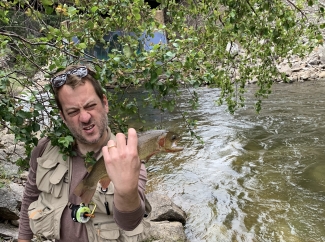Dustin Swales works for NOAA-GSL where his primary role is leading the development of the CCPP Framework, the physics coupling infrastructure used by NOAA UFS applications. The Framework is used by a wide range of users beyond NOAA, and so a significant piece of this role requires working closely with collaborators at NCAR to develop this Framework across modeling applications. Tangential to this, he works on CCPP Physics development, the physical parameterizations enabled by the Framework. This involves working closely with physics developers, both internal and external to NOAA, to incorporate their advancements into NOAA operations.
He hails from Pittston, Pennsylvania, near Scranton where he grew up with a slightly older brother, who now lives in Colorado with his family as well. From an early age, he enjoyed spending time outdoors exploring. Fortunately his family home offered ample outdoor recreational opportunities nearby, whether this meant exploring old-growth forests in the Pinchot State Forest, searching (often unsuccessfully) for wild trout, or on a mission to harvest enough wild berries to bake muffins.
Dustin attended Penn State, and randomly picked Meteorology as a major without giving it too much consideration. It turned out to be a very good fit! He’d always enjoyed math and the physical sciences, so studying the atmospheric sciences satisfied his innate curiosities. He received his B.S in 2007 and M.S in 2009. As a graduate student, he built a shallow water model to explore near-frontal surface wind patterns observed by space-borne radar. At some point during that period, he became inspired to learn about computational methods and scientific programming. The first job he landed was at NOAA/NESDIS in Camp Springs MD, where he worked on algorithm development for ozone-observing instruments for a NOAA mission.
As it is for many of our staff, Dustin and his wife were always drawn to Colorado, and after three years of discussion, they finally made the move. His wife Amanda took a job teaching in Denver Public Schools and still works at the same school today. Dustin took a position at NOAA/PSL (CIRES). While working there, he split his time between two groups, enabling him to work on a variety of often disparate projects. With one group, he studied atmospheric rivers (ARs) and the pathways by which moisture is transported through the complex terrain of the Intermountain West, a region for which the stakeholders had a great deal of interest, given ARs’ hydrological impact on water resources. Concurrently, his work with the other group focused primarily on physical parameterization development, mostly relating to radiation and clouds. After 10 years at PSL/CIRES, he moved to NCAR/RAL to work on development for the CCPP Physics and CCPP Single Column Mode as part of the DTC. In 2023, he moved to NOAA/GSL, still with the DTC, to lead the development effort of the CCPP Framework.
A typical day for Dustin starts by waking up early with his 7-month old son, Dean. Currently he divides his time working on a few DTC projects along with other NOAA/GSL projects. On the DTC side, his main focus is unifying the development efforts for the CCPP Framework occurring at both NOAA and NCAR. Outside of the Framework, he also works on CCPP Physics development, lately with a focus toward making the library of parameterizations more interoperable. Outside of the DTC, he works on other CCPP-related projects, such as using Machine Learning algorithms in the CCPP and enabling the use of GPUs in the CCPP.
Where’s the reward for him? He feels many of his projects lie in the research-to-operations realm or related to operational development and support, and it’s deeply rewarding to support this mission. Building better software (hopefully) makes it easier for scientists to innovate, which in turn makes better forecasts.
